Trey Hartt, (Richmond, VA) | February 3, 2016
Performing Statistics is part of Alternate ROOTS’ 2015-16 Partners in Action cohort.
“If you were me you would know that I love my family; that I’m a respectful person; that I have the talent to do anything that everyone else can do; that I need people to start believing in me and stop judging me by my character; that I’m not a thug because I’m black…”
Malik recorded these words that were eventually produced into a series of radio PSAs calling for a radical transformation of Virginia’s juvenile justice system. In a small booth in Richmond, Virginia, at the local independent radio station with the support of Mike Williams, aka DJ Mikemetic, ten teens ages 15 to 18 laid down tracks that educated their audiences on who they were, the futures they saw for themselves, their fears, challenges, and dreams.
In this moment they gave voice to the young people they saw themselves as, not the criminals that society deemed them to be. And it was from their thoughts, words, and actions that the Performing Statistics project has pushed forward a progressive agenda calling on the end of youth prisons in Virginia.
Performing Statistics, one of the current Partners in Action projects supported by Alternate ROOTS, breaks down the invisibility and marginalization our young people locked up in youth prisons face, by connecting their stories and ideas with artists, community activists, and legal experts to advance the movement for youth justice. Based in Richmond, Virginia the project grew out of the question, “How would the movement for youth justice look if it were led by incarcerated youth?”
This was the central question that launched the project. With project leader Mark Strandquist, myself (a ROOTS member since 2007), creative youth development experts at ART 180, and legal experts at Legal Aid Justice Center supported by attorney Jeree Thomas, we visioned a world where incarcerated youth were valued as human, not just statistics – solutions to our broken system, rather than the problems – to ensure that the voices of those most impacted were at the forefront of change.
Over the course of eight weeks in the summer of 2015, ten young men from the Richmond Detention Center left the detention center and traveled to ART 180’s art center for teens in the Jackson Ward neighborhood – a place once described as the “Harlem of the South” where Maggie L. Walker pushed forward radical concepts of economic freedom for African Americans during the Depression. There they spent three days a week learning about the system they were trapped in, understanding its effects on young people just like them across Virginia, and courageously telling their stories and offering their solutions for change.
Part of the stipulation working with currently incarcerated youth was that they were forbidden to show their faces on any creative materials or in any documentation of the project. This became a creative challenge to overcome and an all-too-real metaphor for the marginalization and dehumanization they feel daily. In their first project they used photography to capture a series of hand gestures and slogans symbolizing protests to the system.
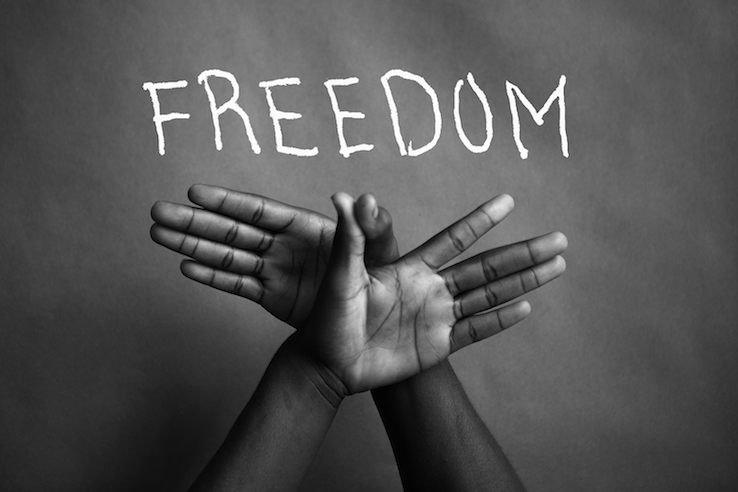
Their second project introduced them to the art of screen-printing with Molly Fair, a local printmaker and member of the Just Seeds Collective. Each young person developed a series of protest images that were eventually screened onto posters and t-shirts. We, as organizers, began to understand the insidious effects of keeping a young person locked away in a cell. One person illustrated the iconic image of two people talking to each other on a phone with their hands mirroring each other through a thick wall separating their bodies. Above the illustration he wrote, “We fear being forgotten, being gone for too long.” What does it say about a society that believes any child deserves to feel like their presence on earth is not worthy, that instilling the “fear of being forgotten” is a healthy way to support their development?
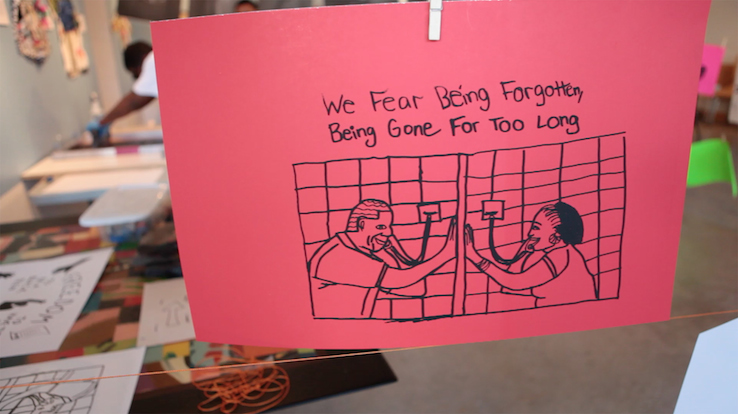
After screen-printing, the young men moved onto the radio production mentioned earlier. It was important to us to hear their voices not just read their words, so they worked through their vulnerability with DJ Mikemetic to talk about the realities of their situation and what needed to change in the community to support young people like them. Their voices can be heard by calling 804-234-3698 and pressing an extension number 1-11.
Each project built on the next as they became more comfortable expressing themselves creatively. After radio production they returned to photography, this time turning the camera on themselves. Local photographer Terry Brown brought her equipment to ART 180 where the guys had the freedom to explore their identity through portrait photography. In response to the prompt, “If you knew me you would know that” each teen wrote a short poem and explored the use of light, shadow, and obstruction to reveal their identity in powerful ways. These portraits became central to the project’s public component.

In the final two weeks, the young men explored a variety of creative outlets that told the true story of incarceration and their vision for a world that replaced courtrooms with classrooms. They wood-burned poetry about their experiences living in a cell that became the floorboards to a life-size replica of a typical cell. Walk six feet one way, eight feet another, and imagine yourself standing in a room eight feet tall. This jail cell became the central piece to the Performing Statistics touring installation. Through this the project asks the public to answer the question, “How can we create a world where no youth are locked up?” The public’s answers are recorded on red tags affixed to the bars of the cell.
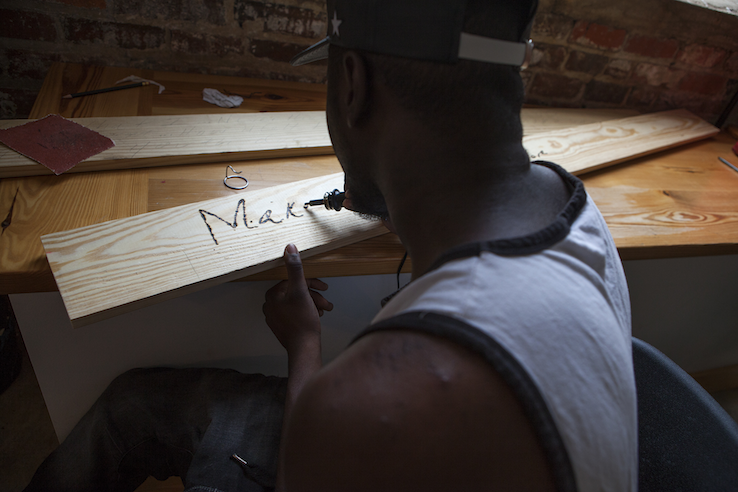
They then spent time directing their energy toward law enforcement by creating a three-part training manual. Each part highlighted a different message: 1) “Before you work with teens…” 2) “If you stop a teen…”, and 3) “What it means to be a guardian.” The manuals were created using the images they created in earlier projects and a collection of poems addressing each of the themes. Since the summer, the manuals have been used to train all of Richmond City Police Department’s new recruits with plans underway to expand the training to all veteran officers. Learn more about the training here.
And for their final project, the young men created protest chants that called on us all to “Speak Up! Speak Out! Silence is Violence!” and “Stop arresting us! You should invest in us!” That final day, with community members, artists, musicians, and staff from ART 180 and Legal Aid Justice Center, we came together to celebrate these young men, celebrate their courage and strength, and remind them that we see them, we hear them, and we will not allow their voices to be silenced.
And then they boarded the van and headed back to the detention center. For eight short weeks we created a community that looked to each other for solutions to complex problems, not the institutions. But it was short lived, and we knew that the hard work was just beginning. It was now time to shift our energy from the individual to the system. Organizers and community activists carried their messages into public spaces.
An exhibition was launched at ART 180 gaining the attention of more than 1,000 people, which then transformed into a mobile version currently touring the state:
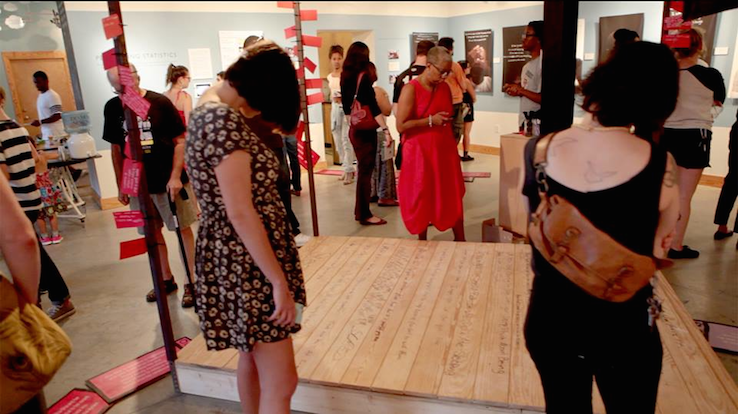
ART 180 and Legal Aid Justice Center hosted a town hall meeting with the Director of the Department of Juvenile Justice using the exhibition as the backdrop:
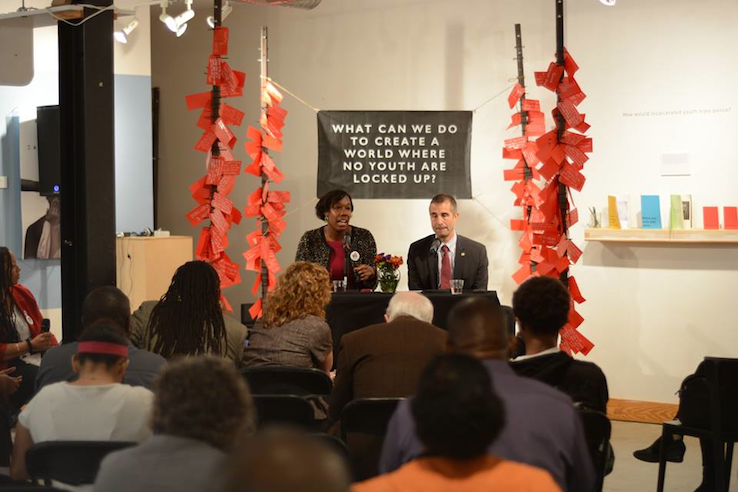
200 community members gathered to declare “Prisons Don’t Work!” and carried oversized versions of the teens’ portraits, along with their posters, t-shirts, and other statistics about Virginia’s juvenile justice system from the Virginia General Assembly building down the main street in Richmond during rush hour:
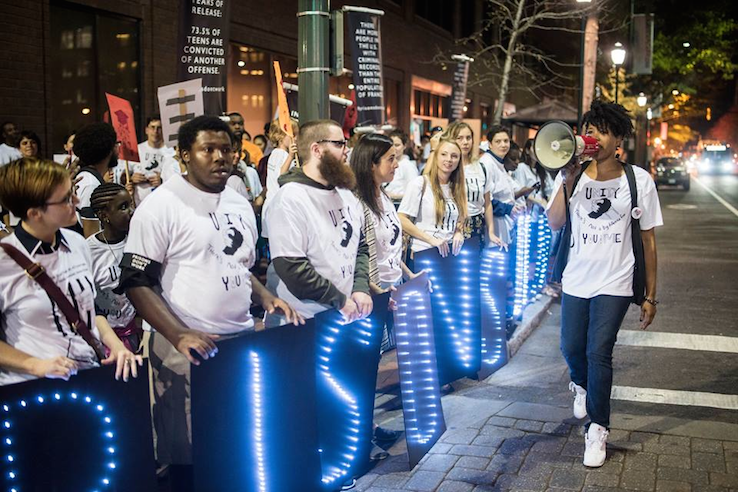
All 21 new recruits to the Richmond City Police Department were trained using the exhibition and the teens’ police training manuals:

The recordings were played at the state budget hearings in front of members of Virginia’s House Appropriations Committee and Senate Finance Committee:

And on President’s Day, the work will be presented in one-on-one meetings with legislators at the inaugural youth lobby day calling on our state legislators to invest in community-based alternatives to incarceration when they vote on Virginia’s two-year budget in March. You can read more on this here.
Though there is still so much work to be done to transform the system, it’s clear that Virginia will not stand silent on the injustices being committed against our youth. We boldly declare that prisons don’t work, and we’re committed to making sure that the young people and families most impacted maintain the right to demand the change they wish to see.
…..
Further Reading:
- For more information about Performing Statistics visit www.performingstatistics.org
- For more information about Virginia’s campaign for youth justice visit www.riseforyouth.org
- Learn about the Robins Foundation grant that will expand this project to a three-year initiative here.
 Based in Richmond, Virginia, Trey Hartt works as the Resource Development Manager at ART 180, a youth arts nonprofit. He was introduced to Alternate ROOTS in 2007 when he performed uncle tom: deconstructed with The Conciliation Project (TCP) at the 2007 Annual Meeting. He has served on TCP’s board since 2006 and continues to do so. Currently he is working on the Performing Statistics project (a 2015 Partners in Action grantee) connecting incarcerated youth to the leading artists, legal experts, and community activists in Virginia to advance juvenile justice reform.
Based in Richmond, Virginia, Trey Hartt works as the Resource Development Manager at ART 180, a youth arts nonprofit. He was introduced to Alternate ROOTS in 2007 when he performed uncle tom: deconstructed with The Conciliation Project (TCP) at the 2007 Annual Meeting. He has served on TCP’s board since 2006 and continues to do so. Currently he is working on the Performing Statistics project (a 2015 Partners in Action grantee) connecting incarcerated youth to the leading artists, legal experts, and community activists in Virginia to advance juvenile justice reform.
